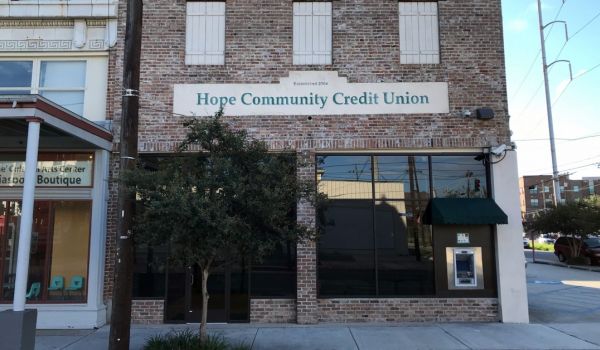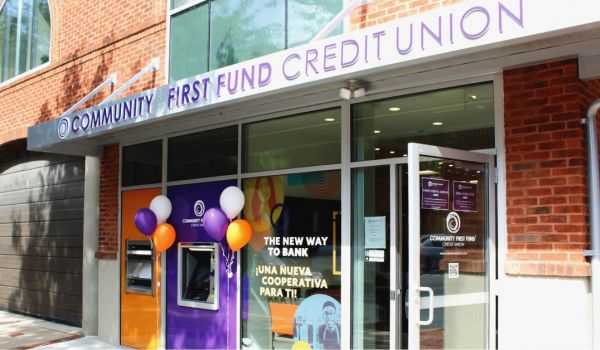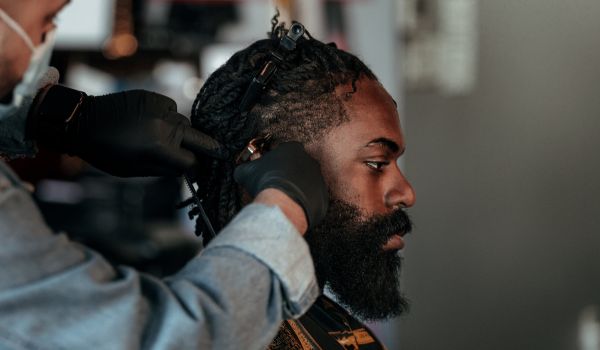Bill Bynum spent one morning this September with his senior staff and a few board members at the National Memorial for Peace and Justice, in Montgomery, Alabama, walking among the 800 or so steel columns that memorialize the victims of racial terror lynchings. There’s one column for every U.S. county where a racial terror lynching took place.
The group went on to spend the afternoon reflecting on what the experience meant for their work at Hope Credit Union, based in Jackson, Mississippi.
“Economic justice is the ongoing work of the civil rights movement in this country, and we take that very seriously,” says Bynum, CEO of Hope Credit Union. Economic justice, Bynum points out, was the work Dr. Martin Luther King, Jr., was turning toward at the time an assassin’s bullet took his life in 1968.
That same evening in Montgomery, the group held a reception, followed the next morning by a grand opening ceremony, in celebration of Hope Credit Union’s Montgomery branch location, its first in Alabama. Joining Bynum and others to cut the ribbon were longtime Hope Credit Union member Reena Evers-Everette, the daughter of civil rights icons Medgar and Myrlie Evers; as well as Dr. Farrell J. Duncombe, senior pastor of Saint Paul African Methodist Episcopal Church, where Rosa Parks once attended.
As part of the festivities, the credit union also announced a second branch location in Montgomery. From just seven branches before the Great Recession, the two Montgomery branches are Hope’s 31st and 32nd locations across the Deep South, from Jackson and the Mississippi Delta to Memphis, Tennessee, to Little Rock, Arkansas, to New Orleans and now Montgomery.
Expanding a credit union is no easy task, especially one such as Hope, which has a mission to serve historically marginalized communities in the Deep South, communities that have survived generations of exclusion at best, and predation at worst, by financial institutions of many kinds. To finance its expansion, Hope has gone where few credit unions have ever gone — to outside investors, who currently have $20 million invested in the credit union.
“We are in a region that is capital starved, so we’ve got to go outside our region and try to import capital,” says Bynum.
What Bynum could have said instead was that much of the South’s capital was stolen, in the form of white plantation owners stealing wages from enslaved black workers before the Civil War, or white planters stealing compensation from black sharecroppers after the war. So there’s something poetic today about Bynum traveling to other regions of the country seeking capital to invest in the growth of a member-owned financial institution in the South, especially when 72 percent of Hope’s nearly 50,000 members are black.
Hope provided more than $100 million in loans in 2017, its first ever nine-figure lending year. That total includes 61 business loans, 2,825 consumer loans, and 287 home mortgages, of which 87 percent went to first-time homebuyers. The credit union also added 10,000 new members in 2017.
And yet, many more in the South remain beyond the reach of Hope or any banking institution for that matter. Thirty percent of southern households are unbanked or underbanked, according to the FDIC — a rate higher than in any other region of the country. In the Jackson metropolitan area, 38 percent of households are unbanked or underbanked. In Alabama, 36 percent of households are unbanked or underbanked. (“Underbanked” means the household has at least one bank account holder, but still obtains financial services or products from outside the formal banking system.)
Payday lenders are often stepping into those financial services gaps, charging typical annualized interest rates of 521 percent in Mississippi or 456 percent in Alabama, according to the Center for Responsible Lending. And then there’s Hope; the credit union says a third of its members were unbanked before joining.
True to its member-owned nature, Hope’s $20 million in capital from outside investors has come in the form of specialized loans, preserving member-ownership. Known as “secondary capital” in credit union jargon, the specialized loans aren’t available to every credit union. Under the rules set by the National Credit Union Administration (NCUA), the federal agency that regulates and insures the credit union industry in the U.S., only low-income designated credit unions are permitted to raise secondary capital.
A credit union qualifies for low-income designation if a majority of its members are low-income — which the NCUA defines generally as having a family income up to 80 percent of the median family income for the family’s metropolitan area. As of June 2018, there were 5,480 federally-insured credit unions, 2,544 of which carried a low-income designation, and three-fifths of those only obtained the designation since 2012, when the NCUA made it easier to obtain.
Secondary capital is one of the major perks of being a low-income designated credit union. The specialized loans also must have very specific conditions — including a minimum term of five years, and they must be “subordinated debt,” meaning the investors recognize they’re taking the risk that if the credit union folds during the term of the loan, they’re the last in line to have their debts settled and in all likelihood would lose their investment.
The relatively risky terms don’t exactly attract investors in droves. Cathi Kim, who directs the community development investment program at the National Federation of Community Development Credit Unions, says secondary capital investors have primarily been philanthropic foundations, along with a few banks for whom secondary capital loans can help meet their obligations under the Community Reinvestment Act.
The Annie E. Casey Foundation, Kresge Foundation, Winthrop Rockefeller Foundation, and Mary Reynolds Babcock Foundation have all made secondary capital investments in Hope, according to Bynum. But the biggest player in the secondary capital space, and one of the earliest, has been the Ford Foundation.
Right after the National Federation of Community Development Credit Unions successfully advocated for federal regulators to approve secondary capital as an option for credit unions in 1996, Ford partnered with the Federation to make some of the first secondary capital investments, according to Clifford Rosenthal, the longtime former CEO of the Federation.
The Federation still partners with Ford to invest secondary capital with some of the Federation’s 200 or so members, all of them credit unions that specialize in serving populations with limited access to affordable financial services. Hope Credit Union currently has a 12-year, $5 million secondary capital loan from the Ford Foundation.
“For our foundation, it’s very important that we think about philanthropy broader than grant dollars,” says Jose Garcia, a program officer at the Ford Foundation.
As Kim explains, one of the factors that foundations have found attractive is that, based on federal regulations, each dollar of secondary capital enables up to ten dollars in loans to credit union members.
Overall, federally-insured credit unions had $248 million in secondary capital as of June 2018, according to NCUA data. But only around 70 credit unions currently have any secondary capital, and most of it is in the hands of just a few. The lion’s share is with Self-Help, a family of credit unions based in North Carolina. Self-Help had $130 million in secondary capital as of June 2018, which has helped finance its expansion into a $2 billion credit union family with branches now in five states. Throw in Hope’s $20 million, and that’s 60 percent of all the secondary capital in the credit union industry.
Why do so few eligible credit unions raise secondary capital? Kim suspects it has something to do with the challenge of having a proper plan in place to scale up the credit union after taking on secondary capital investment. It’s hard enough to serve low-income populations. It’s a big risk on top of that for a credit union to take on additional capital, especially in the form of a loan. But Self-Help and Hope’s track records as credit unions with a focus on economic inclusion show that it can be done.
“I think inclusion is a successful business model, and it’s a great growth strategy,” says Kim.
It’s no coincidence that Hope has had success with secondary capital. Bynum started out as one of the first Self-Help employees in the 1980s, before moving to Mississippi to help found Hope in 1995. As with Bynum’s initial move to Jackson, Hope today goes only where communities reach out first.
“We can’t go anywhere until we have the resources, but even before that we’ve got to be invited,” says Bynum. “We are a community-owned, community-driven financial institution. We’re not controlled by a few distant shareholders. Residents are the ones who shape and inform our work. If a community expresses a desire to have Hope in their community or town, we’ll start working with them and we’ll make clear what we need to make that happen.”
This article is part of The Bottom Line, a series exploring scalable solutions for problems related to affordability, inclusive economic growth and access to capital. Click here to subscribe to our Bottom Line newsletter.

Oscar is Next City's senior economic justice correspondent. He previously served as Next City’s editor from 2018-2019, and was a Next City Equitable Cities Fellow from 2015-2016. Since 2011, Oscar has covered community development finance, community banking, impact investing, economic development, housing and more for media outlets such as Shelterforce, B Magazine, Impact Alpha and Fast Company.
Follow Oscar .(JavaScript must be enabled to view this email address)


















